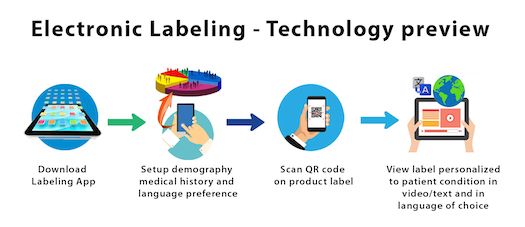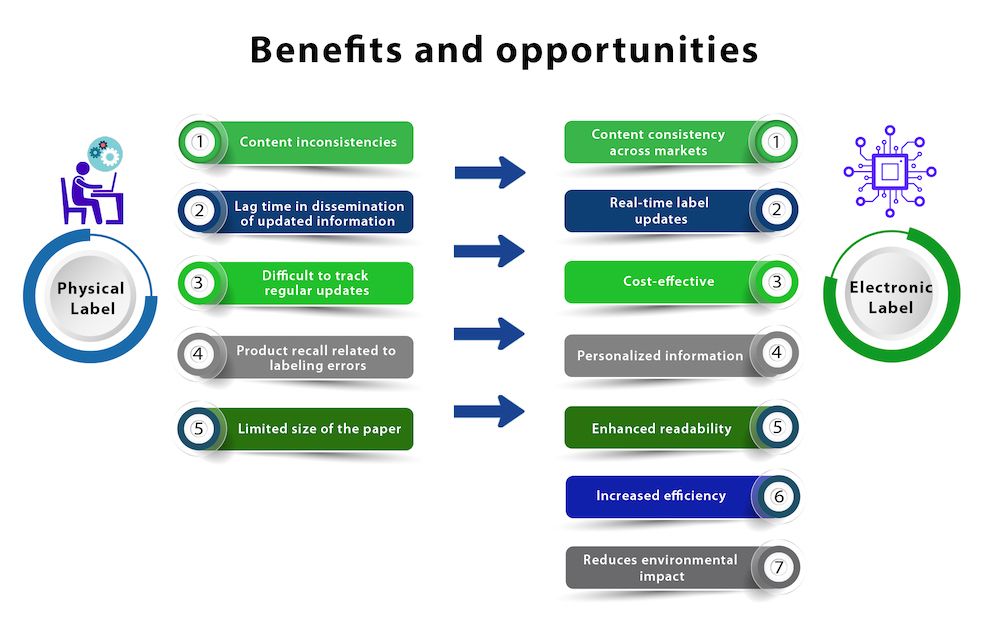E-Labeling: Change is Underway
Priyanka Chaudhary and Vikram Shetty outline the current challenges and opportunities presented by e-labeling around the world.
The package insert or prescribing information is the key mechanism used by pharma companies to communicate significant information about their drugs, according to national requirements, to healthcare professionals and patients. Approved labels are printed and distributed to end-users along with the medicinal products. Revisions to these approved labels (which could occur more than once a year) are time consuming and there is a lag from the time the information is updated to when it is made available to consumers. This can lead to potential risk to patient safety.
For pharma companies, there are challenges in printing and distribution of the updated labels incurring huge cost. Currently, companies rely on paper/physical package inserts. The challenges facing physical labels are due to their inflexibility and non-scalable processes. Pharma companies encounter multiple problems tracking and implementing frequent label updates in order to provide accurate information to the patients and healthcare professionals. Removal of labels from the market becomes even more problematic in the case of a product recall. There can be content inconsistencies across markets due to region-specific regulations, along with increased cost associated with physical labels. The physical nature of labels can also result in delaying the dissemination of safety information to both healthcare professionals and patients. Similar challenges face product recalls. Often due to limited size of the paper, text can be cramped, resulting in impaired readability. In addition, physical labels do not provide personalized information, hence the patient has to search for the relevant text.
There is significant time and cost involved in the regular update of physical labels. On average, a product label is updated five times in a year; pharma companies spend millions of dollars updating artwork, printing, and working out the logistics for distibuting updated labels. There is a significant cycle time from signal detection until the information is made available to the end-user, which includes health authority (HA) approval. It can take three months to three years for one signal or update to reach the healthcare professional or patient.
Change is underway
The pharma industry’s challenges associated with physical labels can be mitigated by adapting electronic drug label (e-labeling) in addition/or over the physical product information. With AI solutions and content management system, the time taken by internal stakeholders for each step can be reduced and, as a result, labels can be updated faster.
It is the electronic version of the package insert (PI) and patient information leaflet (PIL), which is distributed via electronic means, such as through a machine-readable QR code, barcode or URL on the product carton.

The QR code can be linked to a web page that can be updated to include additional information. Companies using XML technology can share information easily with partners, suppliers, and endâusers, in addition to FDA. Clinical researchers and practitioners can communicate more closely through shared XML data, and even translators and other service vendors can gain faster access to the most up-to-date information to move projects (such as updates) along more quickly. XML technology can help manufacturers to lower costs as well as shorten project cycles. This technology enables information to reach in real-time and directly to the healthcare professional/patient.
Benefits and opportunities
Click to enlarge

Prescriber information leaflet contains information pertaining to all the registered medical conditions for each age group. It also contains an exhaustive list of reported adverse events for known conditions. Such detailed information can misguide the patients and, in some cases, important dosing instructions are missed or overlooked by the patient. E-labeling can:
- transform static documents to dynamic resources
- deliver personalized, user friendly patient information considering patient's medical conditions in video/text and in language of choice
- offer changeable font type and letter size for elderly patients or individuals with vision problem
- offer a search function facilitating easy access to safety information
- disseminate information in a more presentable and user-friendly manner, e.g., a video on how to self-administer a particular medication.
E-labeling can reduce manual intervention and produce consistent quality information that can further improve patient safety and brand integrity. This automated process can also improve compliance, provide personalized labels to healthcare professionals and patients, enhance utility and increase efficiency, reduce environmental impact, and is cost-effective.
Electronic labeling landscape and regulatory acceptance
Globally, the shift towards e-labeling has become inevitable. There is a need for harmonization of the regulations and various regulatory agencies are working towards refining the guidance for the implementation of e-labeling.
In 2015, FDA mandated the electronic distribution of package inserts for companies marketing their products in the US. Any drug with incomplete or inaccurate electronic prescribing information was misbranded. FDA also included guidance on how to provide the electronic submissions of different types of drug applications (e.g. NDA). Once approved by FDA, labeling documents are available on the official FDA website DailyMed. But not much has been reported with regard to interlinking e-labeling, which leaves a gap that needs to be fulfilled.
In January 2020, the European Medicines Agency (EMA) issued guidelines to implement electronic product information (ePI). According to these principles, ePI is the “authorized, statutory product information for medicines in a semi-structured format created using the common EU electronic standard. It is adapted for electronic handling and allows dissemination via the world wide web, e-platforms, and print.” But there is a need to further improve the readability of product information onscreen in addition to the advantages of structured data.
On the other hand, Health Canada is already undergoing transition to an XML format of product label and is accepting drug information in XML format on a “by-request” basis, which will become a mandatory requirement after the successful transition.
Emerging markets
In the ASEAN regions, each country has its own regulatory/labeling regulation. This is still evolving and there is lack of harmonization. Adoption of electronic labeling is progressing very slowly due to lack of universal labeling standards. Several health authorities from these regions are discussing the possibilities of implementing e-labeling.
Regions such as Australia, Singapore, China, and Malaysia have adopted structured text for labeling, according to defined standards. The Japan Pharmaceutical Manufacturers Association (JPMA) requires product information in the form of Standard Generalized Mark-up Language (SGML), HTML, and PDF format. Revised guidelines in 2019 proposed the implementation of electronic labeling.
In Taiwan, e-labels are posted on HA website. TFDA published an app in 2016 (downloadable to mobile phones), which is used to scan 2D barcodes on drug carton to access drug information on the HA website. The local health authority in Malaysia also publishes drug information on its website.
One of Janssen’s initiative is a platform called Integrated Smart Trial & Engagement Platform (iSTEP), which is incorporated into clinical studies/trials. This system automatically tracks the delivery of medication kits to the patients and electronic drug labels inform them in real-time of the changes they need to make in their regimens.
Making electronic label a reality
To secure electronic labeling as a reality, robust content management powered by AI is warranted. An integrated content model needs to be developed to ensure consistency across the labels in various markets. AI along with Natural Language Processing (NLP) business rules can be coupled with local country requirements to manage drug labels with minimal human intervention. This can also generate adverse-event lists and compare different labels. In addition, the personalization of labels needs strong data analytics and robust business rules, so that correct information can be accessed by the individual without any difficulty. Content mapping will help to automate the flow of information from multiple data sources to the respective product labels.
Conclusion
There is a compelling need to further automate labeling process in order to ensure content consistency across markets. Adopting e-labeling will provide detailed and personalized information on a product with a positive environmental impact and improved traceability of products.
Priyanka Chaudhary is Lead Labeling Strategist, and Vikram Shetty is Senior Manager, Labeling Solutions, both at Indegene.
Is Artificial Intelligence a ‘Product’? Products Liability Implications for AI-Based Products
April 10th 2025As the physical products we use evolve to become increasingly complex, traditional products liability frameworks may not always fit to provide remedies for harm that can result from using novel product types.